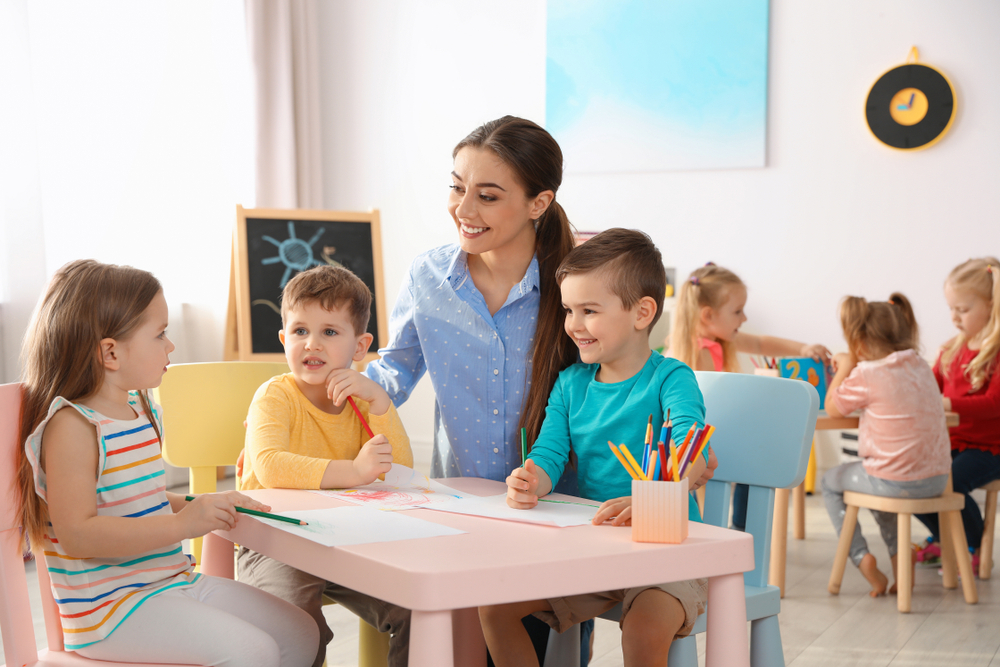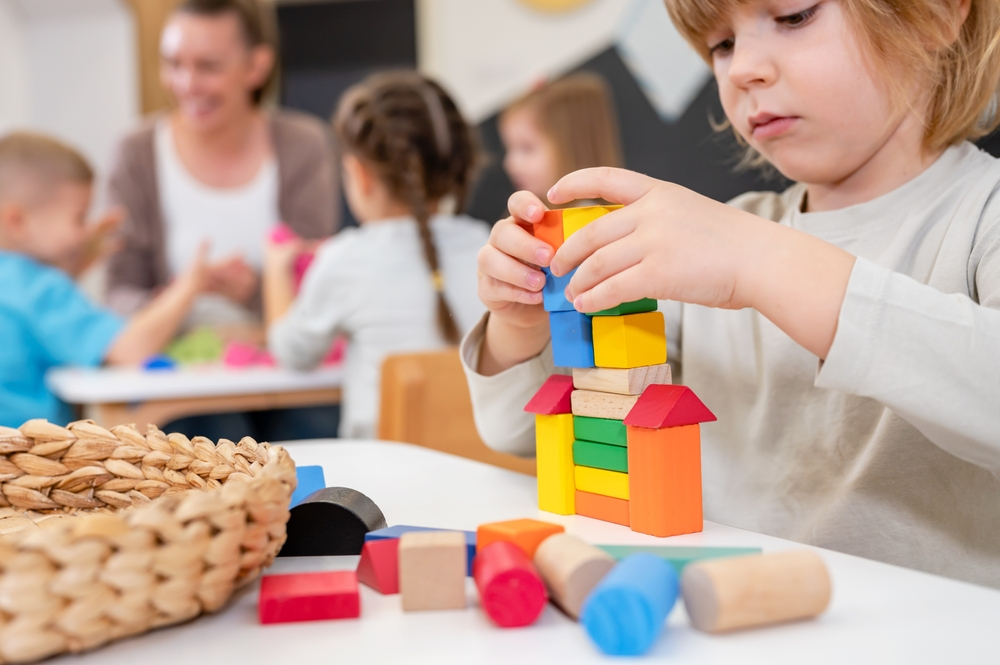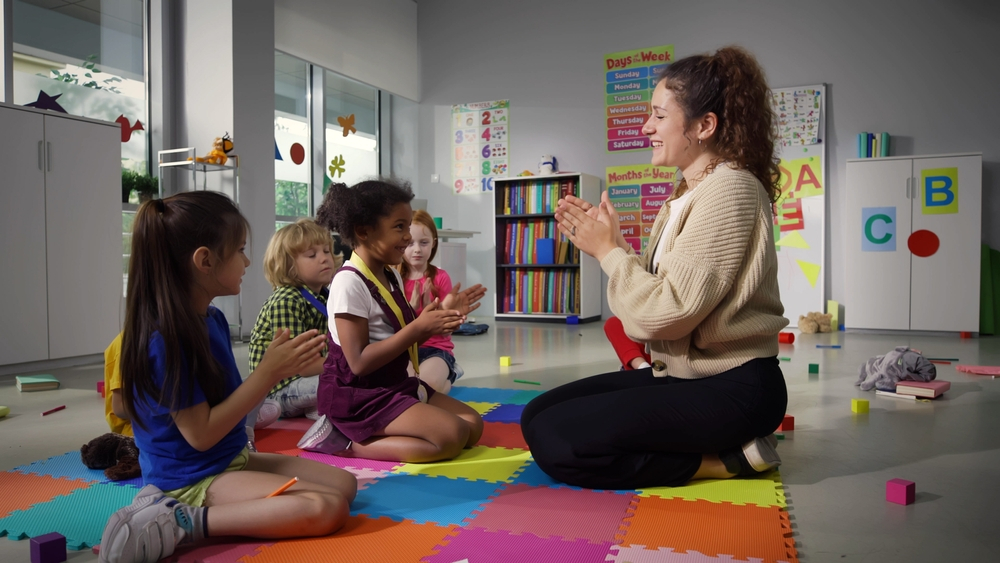
At this tender age, children are just beginning to develop the attention span necessary for structured learning. Teachers face the challenge of designing activities that capture and retain the attention of their young students. This requires a delicate balance between educational content and engaging, playful activities that appeal to the children’s innate curiosity and desire for exploration.
Kindergarten is often where children first learn to interact in a structured group setting. Here, they must navigate the basics of social interaction such as sharing, taking turns, and collaborating. Educators must incorporate social development into their lesson plans, which requires a nuanced understanding of group dynamics among young children.
The physical abilities of kindergarteners vary greatly. While some may have well-developed motor skills, others may still be refining their coordination. Educators must create lesson plans that allow for physical activity and development while being accessible to children at different stages of motor skill proficiency.
Utilizing a blend of instructional strategies, including hands-on activities, visual aids, storytelling, and guided play, can cater to various learning styles and maintain engagement throughout the day. By diversifying their approach, teachers can make each lesson resonate with a broader range of students.
The Key Components of Effective Kindergarten Lesson Plans
Creating effective lesson plans for kindergarten classrooms involves weaving together a fabric of components that each serves a unique purpose in the educational process. Below, we explore the elements that contribute to the structure of robust and nurturing educational experiences for our youngest learners.
Understanding Developmental Readiness
An effective lesson plan begins with a deep understanding of the developmental readiness of kindergarteners, taking into account the various stages of physical, cognitive, and emotional development found within a class.
Setting Clear Learning Objectives
It’s imperative to establish clear learning objectives that align with curriculum standards and promote a progression of skills. These objectives should define what kindergarteners should know and be able to do by the end of each lesson, allowing for a focused and directed learning experience. For instance, a lesson on number sense should have objectives that specify exactly what aspect of number sense children will develop.
Inclusive and Diverse Materials
A variety of inclusive materials and resources should be incorporated to reflect the diverse backgrounds and experiences of students. This might include books that feature characters from different cultures, activities that explore various family structures, or learning tools that are accessible to children with different abilities.
Interactive and Engaging Content
To maintain the interest of young students, lesson plans should include interactive and engaging content that encourages active participation. The use of multimedia, hands-on materials, and real-world connections helps abstract concepts come to life, making learning more concrete and memorable. Interactive storytelling, songs, and educational games are all excellent methods of engagement.
Scaffolded Learning Experiences
Scaffolding is a teaching method that involves providing support to students as they learn new concepts. Lesson plans should incorporate activities that build upon each other, allowing children to gain confidence as their understanding deepens. This might include starting a math lesson with a simple sorting activity before moving on to more complex pattern recognition.
Formative Assessments
Incorporating formative assessments into lesson planning allows educators to gauge student comprehension and adjust instruction as needed. These assessments can be as informal as observing students during an activity or as structured as a quick quiz to test knowledge. The key is to use the information gathered to refine and tailor subsequent lessons for maximum effectiveness.
Reflection and Revision Opportunities
After each lesson, there should be a moment of reflection for both the teacher and the students. Educators can assess what worked well and what might need adjusting, while students can reflect on what they learned and the skills they developed. This reflective practice ensures continuous improvement and responsiveness to student needs.
Integration Across Disciplines
Effective lesson plans often integrate multiple subject areas, such as combining literacy and science as students learn to read through content about the natural world. This not only enhances learning but also helps students make connections across disciplines, seeing the relevance and application of their knowledge in various contexts.
Use of Space and Classroom Management
The physical layout and management of the classroom play a crucial role in the execution of a lesson plan. Educators need to plan for traffic flow during activities, the setup of learning stations, and how to manage transitions to minimize disruption and maximize time on task.
Support and Collaboration
Finally, an effective lesson plan anticipates the need for support and collaboration from colleagues, aides, and specialists. Collaborative teaching strategies, such as co-teaching with a special education teacher or working with a speech therapist, can enhance learning experiences and ensure that all student needs are met.
By thoughtfully combining these components, educators craft lesson plans that are not just instructional blueprints but dynamic tools that adapt to the evolving needs of the kindergarten classroom. This comprehensive approach facilitates a rich educational journey that lays the foundation for lifelong learning.

Creating a Dynamic Learning Environment
A dynamic learning environment is one where students are not only engaged and interested but also actively participating in the learning process. To achieve this, educators can employ various strategies that make lesson plans not only more engaging but also fun and conducive to deeper understanding.
Hands-On Experiments: Incorporate tactile activities that allow children to touch, manipulate, and experiment with materials. For example, a science lesson can include a simple experiment where children mix colors or observe the growth of a plant from seeds. The hands-on approach can significantly enhance engagement and retention of information.
Music and Movement: Using music and dance to teach concepts can be particularly effective, especially for kinetic learners. Learning songs that teach counting or the alphabet, or having dance breaks between lessons, can provide a joyful learning experience while also offering a needed energy outlet for young students.
Interactive Storytelling: Instead of simply reading a story, involve the children in the storytelling process. This could mean having them guess what happens next, act out parts of the story, or even help to create their own ending. This makes the storytelling session more interactive and memorable.
Educational Software and Apps: Use technology to your advantage by integrating educational software that turns learning into an interactive experience. This can include apps that help with letter recognition, basic math skills, or even virtual field trips.
Smartboard Activities: Interactive whiteboards can make lessons highly engaging by allowing students to interact with the content directly on the board. They are great for sorting activities, matching games, and collaborative problem-solving.
Flexible Seating: To add dynamism to the environment, consider flexible seating arrangements that allow children to choose where they feel most comfortable. Options might include bean bags, cushions, or standing desks.
Learning Centers: Create different areas in the classroom designed for various types of activities, such as a reading nook, a math center, or a science corner. Rotating activities in these centers can keep the environment fresh and stimulating.
Student Feedback: Encourage students to give feedback on which parts of the lesson they enjoyed most and what they found challenging. This not only engages them but also helps tailor future lessons to their interests and needs.
Reflection Time: Have a short period where students can share what they’ve learned, possibly through drawings or group discussion. This helps consolidate their learning and provides a sense of accomplishment.
Educators should also commit to lifelong learning and stay updated with the latest pedagogical research and techniques. Sources such as the National Association for the Education of Young Children (NAEYC) offer professional development resources to help transform teaching practices.
By incorporating these strategies, lesson plans can become lively and dynamic, captivating young minds and promoting a love for learning. Furthermore, a dynamic learning environment supports the various learning styles and needs of children, ensuring that each child can thrive and reach their full potential.
Use of Technology in Learning
Technological tools in kindergarten classrooms must be integrated thoughtfully, bearing in mind the developmental appropriateness and the potential for enhancing engagement without overwhelming young learners. The National Association for the Education of Young Children (NAEYC) and the Fred Rogers Center jointly affirm the position that technology, when used appropriately, can be a valuable tool in the learning and development of young children.
Interactive E-books: Digital books with interactive elements can enhance storytelling, with features like read-aloud narration and animated characters that help engage auditory and visual learners.
Educational Apps: Select applications developed specifically for early learning, which focus on foundational skills like phonemic awareness, basic math concepts, and pattern recognition, can reinforce classroom activities in a fun format.
Virtual Classroom Pets: Engaging apps allow children to care for a virtual pet, teaching them responsibility while integrating lessons in science and empathy.

Crafting a Balanced Curriculum
Incorporating a balanced curriculum in kindergarten is like composing a melody with different instruments—each subject area offers a unique tone, yet together they create a harmonious educational experience. Lesson plans that weave together multiple subjects help to build a rich tapestry of learning, enabling children to make connections between different areas of knowledge and see the bigger picture of their educational journey.
Literacy and Reading Skills
The foundation of early literacy lies in developing a love for reading and an understanding of language. In kindergarten, fostering literacy and reading skills is a multifaceted process which includes:
- Phonemic Awareness: Engaging children with sounds of language, helping them recognize and play with the smaller sounds in words.
- Vocabulary Building: Introducing new words through stories, conversations, and thematic units, expanding their language bank.
- Comprehension Skills: Using picture books and simple texts to teach children to understand and infer information from text and illustrations.
- Storytelling: Encouraging children to narrate their own stories, which promotes narrative skills and imagination.
Mathematical and Logical Reasoning
Developing mathematical skills in young learners is about more than numbers; it’s about cultivating an ability to think logically and solve problems. Components of this development include:
- Number Recognition and Counting: Introducing the concept of numbers and their sequences through fun and engaging activities like counting games.
- Basic Operations: Employing simple addition and subtraction within activities, often using physical objects for better understanding.
- Patterns and Sorting: Recognizing patterns and sorting objects by different attributes help establish critical thinking skills.
- Spatial Awareness: Activities that involve shapes and sizes to foster an understanding of geometry in a practical context.
Hands-On Science and Discovery
The natural curiosity of kindergarteners is the driving force behind hands-on science and discovery subjects. This area of the curriculum aims to:
- Promote Observation Skills: Encouraging children to notice details, ask questions, and make predictions about their physical world.
- Conduct Simple Experiments: Engaging learners in age-appropriate scientific investigations that stimulate their sense of wonder.
- Explore Nature: Using the outdoor environment as a classroom to learn about plants, animals, and the elements.
- Foster Environmental Stewardship: Teaching the importance of taking care of the world around them through recycling and conservation lessons.
Creative Arts and Self-Expression
Artistic activities contribute significantly to the development of a child’s self-expression, creativity, and emotional health. A balanced curriculum should incorporate elements such as:
- Art Projects: Working with various materials and techniques allows children to express their creativity and strengthens fine motor skills.
- Music and Rhythm: Integrating music into the curriculum through singing, rhythm exercises, and exposure to different musical genres.
- Dramatic Play: Role-playing and puppetry can enhance language skills, as well as provide a platform for understanding emotions and social interactions.
- Dance and Movement: Dance helps with physical development and can be a joyful way for children to express themselves and learn about different cultures.
In crafting a balanced curriculum, educators should design lesson plans that not only align with developmental milestones but also spark joy and curiosity in young learners. This balanced approach to kindergarten education not only covers a breadth of knowledge but also encourages the depth of understanding, setting a strong foundation for future learning success.
Using Readability for your Kindergarten Lesson Plans
Readability Tutor is an award-winning app for grades K-6. Our interactive voice-based AI tutor is perfect for kindergarteners that are just learning to read. Our Storytime feature starts by reading to young children. As they progress, Readability engages students in real-time feedback, aiding them in fine-tuning their reading abilities while simultaneously growing their vocabulary. It’s like having a personal tutor for every child, ready to guide, correct, and celebrate their reading journey. Our detailed reporting tools provide you with the insights needed to track progress and adjust your teaching strategies effectively.
Take the first step towards transforming your kindergarten classroom into a dynamic, literacy-rich environment where every student can reach their full potential. Try Readability Tutor today and witness the remarkable transformation in your students’ reading journey. Start your free trial now and join the community of educators who are shaping confident and skilled readers for the future.

 Español
Español